List of Japanese flags
This is alist of Japanese flags,past and present. Historically, eachdaimyōhad his own flag.(Seesashimonoanduma-jirushi.)
National flags[edit]
| Flag | Date | Use | Description |
|---|---|---|---|
 |
13 August 1999 – present | Civil and state flag and ensign of Japan. | Flag ratio: 2:3. This flag was designated byProclamation No. 127,1999. The sun-disc is perfectly centered and is a brighter shade of red. |
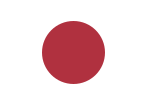 |
27 February 1870 – 12 August 1999 | Civil and state flag and ensign of theEmpire of Japan,and the Japanese state. | Flag ratio: 7:10. Disc is shifted 1% towards the hoist (left). This flag was designated by Proclamation No. 57, 1870. |
Imperial flags[edit]
| Flag | Date | Use | Description |
|---|---|---|---|
 |
1869–present | Imperial standard of theemperor of Japan | A gold 16 petal chrysanthemum centered on a red background |
 |
2019–present | Imperial standard of theemperor emeritus | Similar to the standard of the emperor, but with a darker background |
 |
1926–present | Imperial standard of theempress,theEmpress dowager,thegrand empress dowagerand the empress emerita | Apennantof the standard of the emperor |
 |
1926–present | Imperial standard of theregent of Japan | Similar to the standard of the emperor, but with a whiteborder |
 |
1926–present | Imperial standard of the heir imperial son and the imperial grandson who is an heir apparent | Similar to the standard of the emperor, but with a whiteorle |
 |
1926–present | Imperial standard of the wife of the heir imperial son and the wife of the imperial grandson | A pennant of the standard of the heir imperial son |
 |
2020–present | Imperial standard of the crown prince if not the son of the emperor | A gold 16-petaled chrysanthemum centered on a white background with a red orle and border |
 |
1926–present | Imperial standard of other members of theImperial House | Similar to the standard of the crown prince, but without the red orle |
Governmental flags[edit]
| Flag | Date | Use | Description |
|---|---|---|---|
 |
1872–1887 | Ensign of Japan Post | Hinomaru with a red horizontal bar placed in the center of the flag. |
 |
1892–present | Ensign of JapanCustoms | White represents land, blue represents sea, and the red disc represents the customs on a border. |
Military flags[edit]
[edit]
| Flag | Date | Use | Description |
|---|---|---|---|
 |
1954–present | Flag of theJapan Self-Defense Forcesand theJapan Ground Self-Defense Force | A sun disc design with 8 red rays extending outward, and a gold border partially around the edge. |
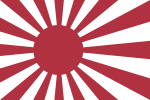 |
1889–1945 | Ensign of theImperial Japanese Navy | Sun disc with 16 rays on a white field, with the disc skewed to the hoist. |
 |
1945–present | Ensign of theJapan Maritime Self-Defense Force | Sun disc with 16 rays on a white field, with the disc skewed to the hoist. |
 |
1955–1957 | Former ensign of theJapan Air Self-Defense Force | Used from 1955 to 1957. |
 |
1957–1972 | Former ensign of theJapan Air Self-Defense Force | Used from 1957 to 1972. |
 |
1972–2001 | Former ensign of theJapan Air Self-Defense Force | Used from 1972 to 2001. |
 |
2001–present | Ensign of theJapan Air Self-Defense Force | Current ensign, used since 2001. |
 |
1972–present | Standard of theprime minister of Japan | Five cherry blossoms on a purple background. |
 |
1972–present | Naval standard of the prime minister of Japan | Five cherry blossoms on a purple background. |
 |
1972–present | Standard of the minister of defense of Japan | Five cherry blossoms on a magenta background. |
 |
1972–present | Naval standard of the minister of defense of Japan | Five cherry blossoms on a magenta background. |
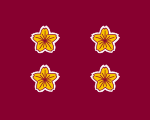 |
1972–present | Standard of the vice minister of defense of Japan | Four cherry blossoms on a magenta background. |
 |
1972–present | Naval standard of the vice minister of defense of Japan | Four cherry blossoms on a magenta background. |
 |
Standard of Chief of Staff, Joint Staff | ||
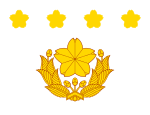 |
Standard of Chief of Staff of the Japan Ground Self-Defense Force | ||
 |
Standard of Chief of Staff of the Japan Maritime Self-Defense Force | ||
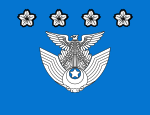 |
1982– | Standard of Chief of Staff of the Japan Air Self-Defense Force | |
 |
1965– | Standard of vice admiral of the Japan Maritime Self-Defense Force | |
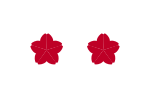 |
1965– | Standard of rear admiral of the Japan Maritime Self-Defense Force | |
 |
1965– | Standard of commodore of the Japan Maritime Self-Defense Force | |
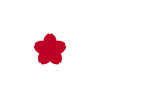  |
1965– | Standards of commander of the Japan Maritime Self-Defense Force | |
 |
1965– | Standard of senior captain of the Japan Maritime Self-Defense Force | |
| 1954– | Masthead pennant of the Japan Maritime Self-Defense Force | ||
 |
1905–1945, 2011– | The "Z flag",unofficial naval ensign | Derived fromInternational maritime signal flag"Z" Made famous by its use to signal the opening of theBattle of Tsushima. |
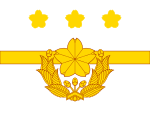 |
Flag of composite forces chief of staff of the Japan Ground Self-Defense Force | ||
 |
1972– | Flag of infantry battalion group of the Japan Ground Self-Defense Force | |
 |
1982– | Flag of air defense command of the Japan Air Self-Defense Force | |
 |
1980– | Flag of the Japan Ground Self-Defense Force reserve | |
 |
1870–1945 | War flag of theImperial Japanese Army | Centered sun disc with 16 rays on a white field. |
 |
1889–1945 | Standard of admiral of the Imperial Japanese Navy | |
 |
1914–1945 | Standard of vice admiral of the Imperial Japanese Navy | |
 |
1914–1945 | Standard of rear admiral of the Imperial Japanese Navy | |
 |
1914–1945 | Standard of commodore of the Imperial Japanese Navy | |
 |
1914–1945 | Standard of commander of the Imperial Japanese Navy | |
 |
1914–1945 | Standard of senior captain of the Imperial Japanese Navy | |
 |
1870–1945 | Standard of duty ship of the Imperial Japanese Navy |
Japan Coast Guard[edit]
| Flag | Date | Use | Description |
|---|---|---|---|
 |
1951– | Ensign of theJapan Coast Guard | The symbol represents a mariner'scompass. |
 |
1951– | Standard of the minister of land, infrastructure, transport and tourism | |
 |
1951– | Standard of the Japan Coast Guard commandant | |
 |
1951– | Standard of the commander of Regional Coast Guard Headquarters | |
 |
1951– | Flag of the commander |
Historical flags[edit]
| 13th century-19th century | Military Flag of the warriors loyal to Japanese court. | A red field with a golden disc in the center and 3 sestiere on the fly. | |
 |
1429–1879 | Merchant Flag of the Ryukyu Kingdom. | A triangular yellow field with a red border and a red disc in the center. |
 |
1580–1587 | Flag of thePortuguese Empireused inPortuguese Nagasaki. | A white field with aPortuguese coat of armsin the center. |
 |
1602–1871 | Flag of theSatsuma Domain. | A horizontal bicolour of red and white. |
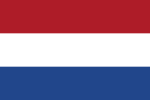 |
1641–1854 | Flag used inDejima | A horizontal tricolor of red, white and blue. |
 |
1603–1868 | Naval ensign of theTokugawa Shogunate.[1] | A bicolour flag consisting of three bands; white, black, and white. |
 |
1905–1910 | Flag of theResident General of Korea. | Ablue ensignwith the Flag of Japan in the canton. |
 |
1945–1952 | Civil and naval ensign during theoccupation of Japan. | Derived fromInternational maritime signal flag"E". |
 |
1797[2]–1879 | Flag of theRyukyu Kingdom. | Features amitsudomoe,the symbol of the rulingSecond Shō dynasty. |
 |
1950 (Jan–Mar) | Proposed flag of Okinawa. | Called the Okinawan Flag(Hướng 縄 kỳ)or the Ryukyu Flag(Lưu Cầu kỳ),proposed by theOkinawa Civil Government.TheUS administrationstated they would decide the flag after the foundation of the unified government of the islands. However, the flag was forgotten ever since. Red, white, and blue represent peace, freedom, and enthusiasm, respectively. A star represents hope. |
 |
1952–1967 | Civil ensign during theoccupation of Okinawa. | Derived fromInternational maritime signal flag"D". |
 |
1967–1972 | Civil ensign of theGovernment of the Ryukyu Islands. | Ryukyus pennant above Japanese flag was used during U.S. occupation of Ryukyu Islands. |
Daimyō Banners present in old paintings[edit]
-
Arima Noriyari
-
Arima Toyōji
-
Arima Toyōji
-
Hayashi Katsumasa
-
Honda Masatomo
-
Hori Naoyori
-
Inoue Masatsugu
-
Katō Akinari
-
Kuroda Tadayuki
-
Kuroda Tadayuki
-
Makino Narizumi
-
Matsudaira Tadakatsu
-
Matsudaira Chikatoki
-
Matsudaira Mitsunaga
-
Matsudaira Naomasa
-
Matsudaira Naonori
-
Matsudaira Shigenao
-
Matsudaira Tadaaki
-
Matsudaira Tadaaki
-
Matsudaira Terusada
-
Mizuno Katsunari
-
Mizuno Katsunari
-
Mori Nagatsugu
-
Nabeshima Tadanao
-
Nabeshima Tadanao
-
Ogasawara Nagatsugu
-
Okudaira Iemasa
-
Okudaira Iemasa
-
Ōtani Yoshitsugu
-
Sakai Ietsugu
-
Sakai Ietsugu
-
Sakikibara Motonao
-
Shimazu Mitsuhisa
-
Tachibana Tadashige
-
Terazawa Katataka
-
Toda Ujinobu
-
Uesugi Mochifusa
Minorities[edit]
| Flag | Date | Use | Description |
|---|---|---|---|
 |
(1996) 1994–[citation needed] | Flag ofMindan | Flag of Mindan, a pro-Southorganization ofZainichi Koreans.The pink flower surrounding thetaegeukis ahibiscus syriacus,the national flower of South Korea. The formal name of the society (Zainihon Daikanminkoku Mindan) is written in kanji in white, and the abbreviation (Mindan) is written inhangulin yellow. The blue field of the flag stands for clear sky and sea. |
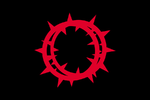 |
1923–1945[citation needed] | Flag of National Levelers Association /Buraku Liberation League | Flag of National Levelers Association, aburakuminrights group, and Buraku Liberation League, NLA's succeeding group. Named theCrown of ThornsFlag(Kinh quan kỳ,Keikanki).Black represents a dark society with discriminations. Red represents blood. |
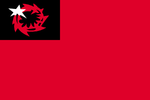 |
1945–[citation needed] | Flag of Buraku Liberation League | The current Buraku Liberation League flag, with a white star representing hope. |
 |
1973–[citation needed] | Flag of Ainu | . |
Cultural flags[edit]
| Flag | Date | Use | Description |
|---|---|---|---|
 |
1919– | Flag of safety | Named the Green Cross(Lục chữ thập,Midori-jūji).Designed by Toshifumi Gamō as the symbol of the governmental "safety week" campaign. The cross represents philanthropism in Western sense, and the place where good deeds gather in Oriental sense.JISZ9103-1986 designates the symbol as the safety indication sign. |
 |
1953– | Flag of industrial health | Announced by the Labour Standards Bureau, the Ministry of Labor of Japan (the currentMinistry of Health, Labour and Welfare), over a public subscription. |
 |
1965– | Flag of safety and health | Designed by the Japan Industrial Safety & Health Association. These three flags are frequently flown on factories or construction sites. |
 |
1887– | Postal flag | The Postal symbol,〒,on a white field. |
Prefectural flags[edit]
Each modernprefecturehas a unique flag, most often a bicolour geometric highly stylised design (mon), often incorporating the letters ofJapanese writing systemand resembling company logos. A distinct feature of these flags is that they use a palette of colours not usually found in flags, includingorange,purple,aquamarineand brown.
Some prefectures also have alternative official flags called "symbol flags"(シンボル kỳ).They may be used on less formal occasions. Famous symbol flags include theone used in Tokyo.
| Flag | Prefecture | Geocode |
|---|---|---|
 |
Aichi | JP-23 |
 |
Akita | JP-05 |
 |
Aomori | JP-02 |
 |
Chiba | JP-12 |
 |
Ehime | JP-38 |
 |
Fukui | JP-18 |
 |
Fukuoka | JP-40 |
 |
Fukushima | JP-07 |
 |
Gifu | JP-21 |
 |
Gunma | JP-10 |
 |
Hiroshima | JP-34 |
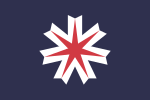 |
Hokkaido | JP-01 |
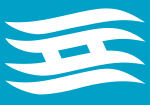 |
Hyōgo | JP-28 |
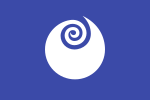 |
Ibaraki | JP-08 |
 |
Ishikawa | JP-17 |
 |
Iwate | JP-03 |
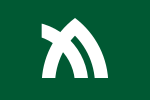 |
Kagawa | JP-37 |
 |
Kagoshima | JP-46 |
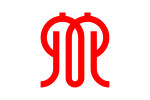 |
Kanagawa | JP-14 |
 |
Karafuto | N/A |
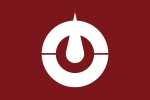 |
Kōchi | JP-39 |
 |
Kumamoto | JP-43 |
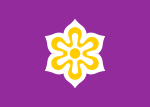 |
Kyoto | JP-26 |
 |
Mie | JP-24 |
 |
Miyagi | JP-04 |
 |
Miyazaki | JP-45 |
 |
Nagano | JP-20 |
 |
Nagasaki | JP-42 |
 |
Nara | JP-29 |
 |
Niigata | JP-15 |
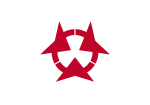 |
Ōita | JP-44 |
 |
Okayama | JP-33 |
 |
Okinawa | JP-47 |
 |
Ōsaka | JP-27 |
 |
Saga | JP-41 |
 |
Saitama | JP-11 |
 |
Shiga | JP-25 |
 |
Shimane | JP-32 |
 |
Shizuoka | JP-22 |
 |
Tochigi | JP-09 |
 |
Tokushima | JP-36 |
 |
Tokyo | JP-13 |

| ||
 |
Tottori | JP-31 |
 |
Toyama | JP-16 |
 |
Wakayama | JP-30 |
 |
Yamagata | JP-06 |
 |
Yamaguchi | JP-35 |
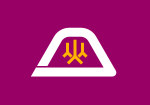 |
Yamanashi | JP-19 |
Municipal flags[edit]
Mostmunicipalitieshave unique flags. Like prefectural flags, most of them are with a bicolour geometric highly stylized symbol, often incorporating Japanese characters.
Political flags[edit]
| Flag | Date | Party | Description |
|---|---|---|---|
| Current | |||
 |
2017–present | Tomin First no Kai | |
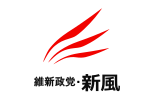 |
1995–present | Ishin Seito Shimpu | |
 |
1982–present | National Socialist Japanese Workers' Party | |
 |
1972–present | Japanese Communist Party | |
 |
1970–present | Kariyushi Club(Ryukyu Independence Movement) | |
 |
1955–present | Liberal Democratic Party | |
 |
1923–1942 1946–present |
Rikken Yoseikaija | |
| Former | |||
 |
2005–2013 | People's New Party | |
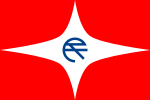 |
1960–1994 | Democratic Socialist Party | |
 |
1945–1996 | Japan Socialist Party | |
 |
1936–1944 | Tōhōkai | |
| Other | |||
 |
1936 | The Righteous Army | The four characters reading "Revere the Emperor, Destroy the Traitors" ( tôn hoàng thảo gian ) are placed in the corners of a standard Japanese flag. |
References[edit]
- ^"Daimyo Flags, 19th Century".
- ^Itai Hidenobu bản giếng anh duỗi (2008).""Naha-kō zu byōbu" ni miru 19 seiki Naha-kō no fune『 kia bá cảng đồ bình phong 』にみる19 thế kỷ kia bá cảng の thuyền (19th Century Boats in Naha Port as Depicted in the Naha Port Folding Screen) ".Hikaku minzoku kenkyū tương đối dân tục nghiên cứu(in Japanese).22(22): 93–136.RetrievedJune 17,2018.






















































































































